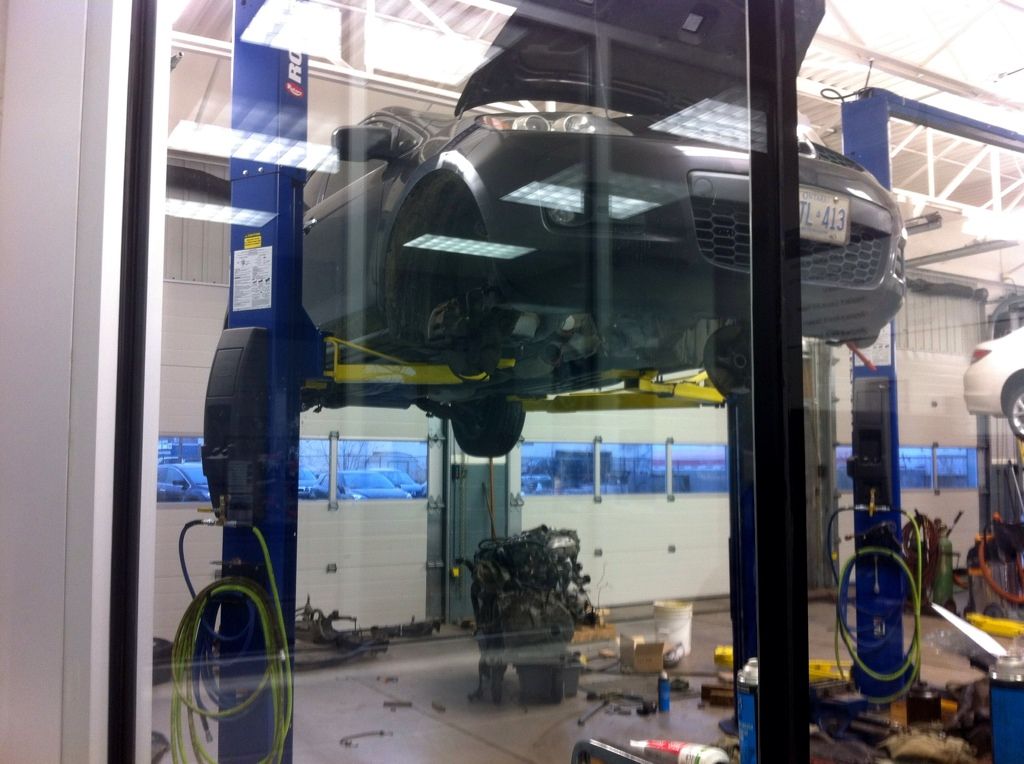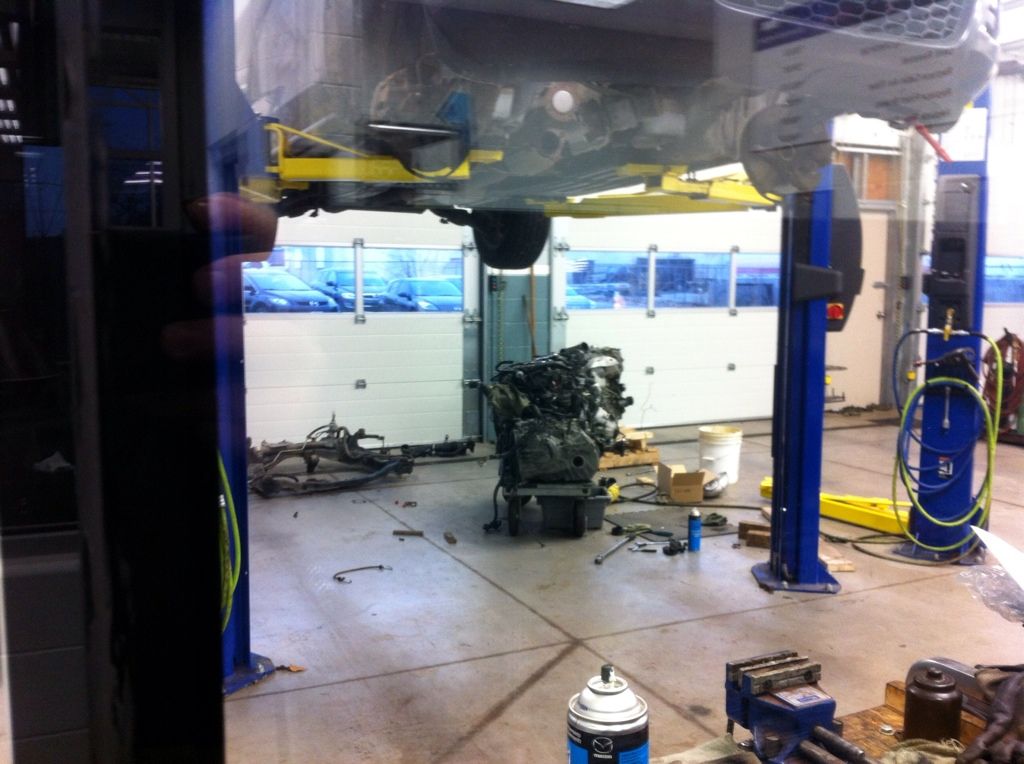|
Cakefool posted:I love how half the marketing blurb for the 3cyl is "lighter, less components, less material", but it's a £1k extra option. The Explorer and Taurus come with a 3.5l V6, you can pay $2k more to go down to a 2.0l I4 with less power and torque.
|
|
|
|

|
| # ? Apr 26, 2024 23:30 |
|
I thought it was only a 995 dollar difference on the Explorer, at least it was when we bought our '12. Ford's theory is people will pay a little more now to save on gas later. Seems to be working since the V6 Ecoboost F-150 seems to have no problem selling. I would say when we were Explorer shopping that Ford just threw the Ecoboost engine into most of the higher trimmed vehicles, so I wonder how many people actually cared about the engine they were getting. I specifically didn't want it since it's a dog in the city.
|
|
|
|
That's not really the best comparison because the ecoboost in the f150 makes more power and torque than the 5.0. It's the top engine by every metric, not just price.
|
|
|
|
lazer_chicken posted:That's not really the best comparison because the ecoboost in the f150 makes more power and torque than the 5.0. It's the top engine by every metric, not just price. Well, maybe not profitability. The 5.0 might be cheaper to make and also possibly cheaper to maintain than the ecoboost. Especially since direct injection is a pretty new technology. Also, I think the 5.0 tends to be slightly lighter in standard setups (though when the whole vehicle weighs 5000+ lbs, you're not going to notice a hundred lbs much).
|
|
|
|
Cream_Filling posted:Well, maybe not profitability. The 5.0 might be cheaper to make and also possibly cheaper to maintain than the ecoboost. Especially since direct injection is a pretty new technology. Also, I think the 5.0 tends to be slightly lighter in standard setups (though when the whole vehicle weighs 5000+ lbs, you're not going to notice a hundred lbs much).
|
|
|
|
grover posted:Direct injection isn't really new technology, it's just that it's only recently been worth the increased cost over low-pressure injection to implement. It's part of the price we pay for more fuel efficient vehicles... I'm talking about things like the carbon buildup issues associated with DI, which aren't a fully settled issue yet. To me, that makes it a new, or at least a less than fully mature technology in its current application. And right now the only real solution if that happens to you is basically disassembling the engine and cleaning it out every so often. I realize that there's ways to design engines to counteract this problem, but the fact that it's snuck up on a number of prominent automakers means it's still a potential issue to keep in mind when looking at long-term costs and reliability since the latest generation of engines hasn't been on the market for very long. Not to mention the generally more complex nature of DI and the super high pressures involved means it costs more to implement, and there's more potential for higher costs down the line once stuff eventually starts needing maintenance or breaking. OXBALLS DOT COM fucked around with this message at 19:56 on Nov 30, 2012 |
|
|
|
Where does the carbon build up? Would a regular seafoaming help?
|
|
|
|
Cakefool posted:Where does the carbon build up? Would a regular seafoaming help? On the back of the valves, mostly. In a non-DI engine, the backs of the valves are constantly being washed with gasoline, keeping them clean. In a DI engine that doesn't happen and the carbon slowly builds up. Newer DI engines have added additional injectors that run once in a while specifically to clean the valves.
|
|
|
|
KozmoNaut posted:On the back of the valves, mostly. In a non-DI engine, the backs of the valves are constantly being washed with gasoline, keeping them clean. In a DI engine that doesn't happen and the carbon slowly builds up. Newer DI engines have added additional injectors that run once in a while specifically to clean the valves. I think most other designs don't go that far, and just try to fine-tune the timing of when fuel is injected to limit fuel contact with the valves, juggling timings to make sure that the intake valves are already mostly closed off before fuel enters the chamber. Also, the really serious issues from the VAG engines where owners are reporting losing 20 hp every 10k miles or whatever were probably exacerbated by the fact that the engines weren't originally designed for DI and had particularly dirty exhaust-gas recirculation systems, which means that all that exhaust getting cycled back into the intake for emissions reasons is bringing with it a lot of soot and carbon that isn't being washed by gas as it would normally be. Actually, how doe Seafoam work, exactly? Is it something you add to the fuel, or is it something you introduce directly into the air intake or something? Does it actually work, or is it just a fad? OXBALLS DOT COM fucked around with this message at 20:17 on Nov 30, 2012 |
|
|
|
Cream_Filling posted:Actually, how doe Seafoam work, exactly? Is it something you add to the fuel, or is it something you introduce directly into the air intake or something? Does it actually work, or is it just a fad? Cool dudes do both. Works like magic.
|
|
|
|
Throatwarbler posted:I heard an interview with Ford engineers and they said the iron block was done on purpose in order to make the engine smaller, and going to Al would not have saved any weight. They also went to a conventional timing belt instead of a chain in order to reduce drivetrain friction. I interviewed Ford engineers on this exact topic (you can read the results at Ars Technica) and Dan Kapp told me that for the 1l 3 cal car, the weight saving with Al wasn't worth the extra effort. He did say that Al would be used for larger derivatives though. Cream_Filling posted:Well, maybe not profitability. The 5.0 might be cheaper to make and also possibly cheaper to maintain than the ecoboost. Especially since direct injection is a pretty new technology. Also, I think the 5.0 tends to be slightly lighter in standard setups (though when the whole vehicle weighs 5000+ lbs, you're not going to notice a hundred lbs much). The EcoBoost now accounts for 40% of F150 sales.
|
|
|
|
Twin turbo ecoboost 2l straight 6
|
|
|
|
http://rumors.automobilemag.com/mot...l#axzz2DjY95wYz A RWD Alfa sedan based on the new Barracuda platform sounds great to me, and the acknowledgement that the entire lineup needs that layout is proof that the brand is in the right hands now. With Ford's ecoboost engines, Fiatsler's multiair engines, and GM's renewed interest in sporty/performance cars, we finally might get to see that Golden Age of American automobiles that perhaps never really was.
|
|
|
|
|
Cream_Filling posted:I think most other designs don't go that far, and just try to fine-tune the timing of when fuel is injected to limit fuel contact with the valves, juggling timings to make sure that the intake valves are already mostly closed off before fuel enters the chamber. VAG isn't the only one using DI and EGR together - Mazda does it in the turbo MZR. I don't know about 10hp lost but I am expecting to see all kinds of unholy hell when I pop my intake manifold off at around 120k. The bottom end of the engine being 'designed' for it doesn't really hold as an excuse - the head absolutely has to be designed for DI, since that's where the injector sits, and EGR/etc is just engine management. Timing isn't the issue either. The problem isn't that "some fuel comes in contact with the valve", it's that no fuel comes in contact with the back of the intake valve whatsoever. DI has a lot of great benefits but carbon buildup on the intake valve is a problem that needs to be solved to maintain those benefits. Cream_Filling posted:Actually, how doe Seafoam work, exactly? Is it something you add to the fuel, or is it something you introduce directly into the air intake or something? Does it actually work, or is it just a fad? Seafoam is an additive designed to be run in all sorts of ways - it can be added to crankcase oil to help clean out sludge, or to the fuel system to clean it out. However, 'seafoaming a car' almost always means directly introducing it to the intake path of the engine by means of a large vacuum line...usually the brake booster as it's often the largest and easiest to access. Does it work? I've never seen anyone actually pull a carboned-up head to show a before, bolt it back on, seafoam it, and then pull it off to show the difference, so it's hard to say. However, I've seafoamed vehicles twice in relatively quick succession, and the second application always nets less smoke than the first, which makes me think there's something it's blowing out of there. Will it work for carbon buildup on a DI engine? No, not in that manner. The other problem is that when you have carbon building up like that on the intake valve that never sees any solvent for years on end, the carbon itself ends up becoming ridiculously goddamn hard. Cobb has put up their own take on the situation (rehosted at my server) where they actually tested a number of different solvents against each other, including Seafoam. It did dissolve the buildup, but only in a situation where it was allowed to puddle in the intake port for a number of minutes; it wouldn't do a drat thing if it was blowing past it into the combustion chamber.
|
|
|
|
Which are the first mass market (sub $40k) cars to use GDI? I'm curious what the long-term reliability ends up looking like. Are the high pressure fuel pumps more likely to fail? Do the injectors get beat up? I'm talking about 150k miles and onwards, really long-term stuff where patterns might not be clear yet.
|
|
|
|
drgitlin posted:The EcoBoost now accounts for 40% of F150 sales. Yeah, but what's the margin on an Ecoboost engine versus a V8? A V8 commands a certain price just because it's a V8, and it's possible that manufacturing costs for what's a relatively simple engine (compared to twin turbos + DI) might be much lower despite being able to charge a lot since it's a bigger engine. Since the ecoboost is still a very new thing on the market, it's possible that they're willing to tolerate smaller profits on the new engine since people need extra incentives to change their minds and also to promote the Ecoboost brand in general. IOwnCalculus posted:VAG isn't the only one using DI and EGR together - Mazda does it in the turbo MZR. I don't know about 10hp lost but I am expecting to see all kinds of unholy hell when I pop my intake manifold off at around 120k. Well, the excuse I've read for the VAG design was that the way they implemented EGR was particularly 'dirty' and allowed more oil and carbon to enter and remain in the recirculated exhaust than other systems did due to specifics of the plumbing, but that this was a problem that wasn't apparent when the system was used on non-DI versions of the same engine. Supposedly, the system GM uses is to try and minimize carbon buildup via timing it so that very little fuel can get on the back end of the intake valve. That's just what I've read. Logically, I guess this sort of makes sense since carbon comes from combustion byproducts, and if no fuel or exhaust is allowed to touch the back of the intakes, there will be no carbon to build up. Of course, in reality, you're going to see some inevitable buildup no matter what since nothing is perfect and there's always going to be mixing of gas from the different stages of the engine. But, yeah, this was my original point that there are still some uncertainties as to the long-term performance/reliability/maintenance requirements of DI engines. Weinertron posted:Which are the first mass market (sub $40k) cars to use GDI? I'm curious what the long-term reliability ends up looking like. Are the high pressure fuel pumps more likely to fail? Do the injectors get beat up? I'm talking about 150k miles and onwards, really long-term stuff where patterns might not be clear yet. Wasn't Mitsubishi the first to use it in the modern era (90s)?
|
|
|
|
Weinertron posted:Which are the first mass market (sub $40k) cars to use GDI? I'm curious what the long-term reliability ends up looking like. Are the high pressure fuel pumps more likely to fail? Do the injectors get beat up? I'm talking about 150k miles and onwards, really long-term stuff where patterns might not be clear yet. If $40k is your limit, and assuming American market, it looks like the earliest contenders might be the 2003 Audi A4, the turbo Solstice/Sky in 2006, the Mazdaspeed6 in 2006 (as well as the MS3 and CX7), and even Isuzu in the 2004 Axiom/Rodeo. Speaking just for the Mazda DISI, the high pressure fuel pumps seem plenty reliable, but they just don't allow for much flow beyond what very light mods require - they get upgraded to support higher fuel flow, not due to failure. Injector seals apparently need to be replaced in higher-powered builds to reduce false knock. Otherwise, the only real DI side effect is the carboned up intake valves.
|
|
|
|
IOC, speaking of Mazda DISI engines, stopped by the dealer to pick up an oil filter and this was in there.  Something didn't go well for him Sockington fucked around with this message at 22:54 on Nov 30, 2012 |
|
|
|
Cream_Filling posted:
Yeah, certain versions of the 4G93 had DI. The Mirage we got in the US didn't have it as an option if I recall correctly. Mine didn't.
|
|
|
|
IOwnCalculus posted:Cobb has put up their own take on the situation (rehosted at my server) where they actually tested a number of different solvents against each other, including Seafoam. It did dissolve the buildup, but only in a situation where it was allowed to puddle in the intake port for a number of minutes; it wouldn't do a drat thing if it was blowing past it into the combustion chamber. Yeah, that's the most effective way to use it. You use a vacuum line to suck it out of the bottle fast enough that the motor's right on the edge of stalling, then shut it off as soon as it's all in, let it sit for like a half hour while you eat some pizza or w/e, then go start it up and drive around as a rolling smog generator.
|
|
|
|
Sockington posted:IOC, speaking of Mazda DISI engines, stopped by the dealer to pick up an oil filter and this was in there. People have been blowing them up since the car came out, practically; there's some thought that the variable cam timing isn't aggressive enough with high throttle at very low RPMs since it seems that the whole purpose of advancing / retarding the cam is to reduce cylinder pressures to livable levels, not to make more peak power. Fucknag posted:Yeah, that's the most effective way to use it. You use a vacuum line to suck it out of the bottle fast enough that the motor's right on the edge of stalling, then shut it off as soon as it's all in, let it sit for like a half hour while you eat some pizza or w/e, then go start it up and drive around as a rolling smog generator. Yeah, but I don't see this as being effective at getting enough in there to actually puddle on the valve. Besides, Corksport's testing showed that it just softened up enough to be scraped out as a goopy mess. I'm going to go the walnut shell route myself.
|
|
|
|
I just got an MS3 and my brother just rolled 100,000 km on his, tell me about the walnut shells, George. (Remove the valves and shell blasting?)
|
|
|
|
Cocoa Crispies posted:Yeah, certain versions of the 4G93 had DI. The Mirage we got in the US didn't have it as an option if I recall correctly. Mine didn't. It was a Japan/Europe thing mostly in the Galant and Charisma. The early Mitsi GDIs gained a fairly bad rep, especially the 4G64 which was a pretty lovely engine all around without the additional DI issues. The six cylinders in the Diamante and Pajero seemed to be much better though. My own car is a Japanese market V35 Skyline with the 3l DI version of the VQ - seems to go fine at the moment but Nissan only did the DI versions for a couple of years before switching back to normal injection which is a little worrying.
|
|
|
|
dissss posted:It was a Japan/Europe thing mostly in the Galant and Charisma. The newest M56/Fuga uses a direct injection VK, so maybe they're getting back on it again. Marchionne basically confirms that there will be a mid size RWD sedan coming that will have both Alfa and Chrysler models, and with the new Miata based Spyder and a mid engine 4C Alfa is going back to RWD. http://rumors.automobilemag.com/mot...l#axzz2DjY95wYz
|
|
|
|
Worth noting that some cars have a seperate set of injectors for response and valve cleaning. Like the FRS.
|
|
|
|
Seems like an overcomplicated solution, there has to be some cleaner way of doing that.
|
|
|
|
D C posted:Seems like an overcomplicated solution, there has to be some cleaner way of doing that. Yeah, it's complex, but the most likely failure mode is for the injectors not to fire, which wouldn't have any affect at all on engine performance for a good long time.
|
|
|
|
Ziploc posted:Worth noting that some cars have a seperate set of injectors for response and valve cleaning. Like the FRS.
|
|
|
|
Q_res posted:Yeah, the big deal about Skyactiv-D is that it's supposed to be able to pass CARB standards without Urea. The only car this is being offered in is the upcoming Mazda 6? I was hoping to find it in a Mazda 3 5 door.
|
|
|
|
tijag posted:The only car this is being offered in is the upcoming Mazda 6? I think they said it would be in the CX5 too, but not the same engine(2.5l vs 2.2l)? A diesel CX-5 would be terrifyingly fast considering the gas version has like
|
|
|
|
D C posted:Seems like an overcomplicated solution, there has to be some cleaner way of doing that. Sounds like a job for Italian Tuning.
|
|
|
|
MarsellusWallace posted:Yeah, it's complex, but the most likely failure mode is for the injectors not to fire, which wouldn't have any affect at all on engine performance for a good long time. I don't know the frequency with which the cleaning injector would fire, but if the injector fails, wouldn't that cause the engine to run lean? Or would a modern ECU be able to detect that and compensate for it?
|
|
|
|
Also, I'd say the argument against complicated designs is as much about the increased costs of production as it is about introducing points of failure.
|
|
|
|
Phy posted:I just got an MS3 and my brother just rolled 100,000 km on his, tell me about the walnut shells, George. (Remove the valves and shell blasting?) Nah, you do it with the head on the engine - it's based on the BMW service procedure for dealing with the same issue on their DI engines. If you make sure a given valve is closed before you work on it, no shell should get past it, but even if it does the shell is softer than the metal so it 'should' get ejected without issue.
|
|
|
|
Not really a NEW new car but still new...ish. http://www.autoblog.com/2012/12/01/morgan-launches-3-wheeler-in-gulf-livery/
|
|
|
|
Cat Terrist posted:Sounds like a job for Italian Tuning. An Italian tune up is the correctly answer for everything. If it breaks, it needed to be replaced anyway.
|
|
|
|
KozmoNaut posted:An Italian tune up is the correctly answer for everything. Can it help with DI carbon issues though? I've been told the only way of dealing with it is a periodic manual clean out.
|
|
|
|
Toyota has redesigned the RAV4, and in the process, removed everything that made it unique in its segment.Autoblog posted:As many suspected, Toyota will no longer offer six-cylinder power for the RAV4. The automaker announced that the standard powerplant will be a 2.5-liter four-cylinder (rated at 176 horsepower and 172 pound-feet of torque) mated to a new six-speed automatic. Consumers will again be offered a choice between front- and all-wheel drive. Fuel economy estimates are 24 mpg city/31 highway (FWD) and 22 mpg city/29 mpg (AWD).
|
|
|
|
Left Ventricle posted:Toyota has redesigned the RAV4, and in the process, removed everything that made it unique in its segment. The v6 is kinda whatever, the i4 in the current Rav-4 is enough for that vehicle anyway. And the side opening door blows rear end, it opens TOWARDS the curb, and good luck opening it in a parallel parking situation anyway. (Still miles better then the CR-V)
|
|
|
|

|
| # ? Apr 26, 2024 23:30 |
|
http://www.autoblog.com/photos/2013-nascar-ss-revealed-in-las-vegas/ So look like the new Chevy SS is most likely going to be an HSV.
|
|
|










































